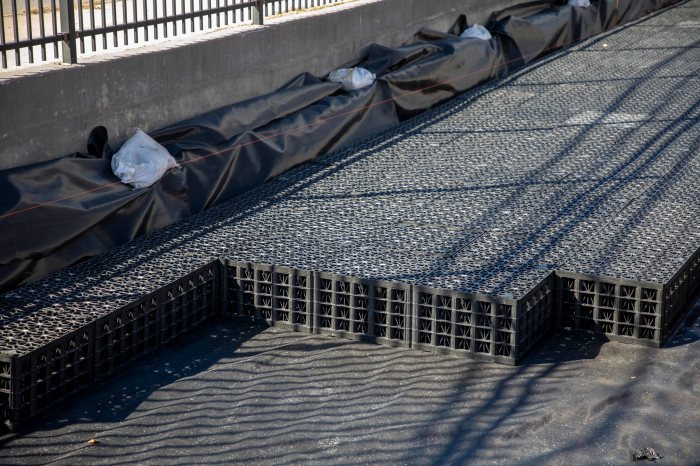The city is testing out a new form of green infrastructure to help prevent flooding in Brooklyn: porous pavement.
Seven miles of porous pavement will be installed along a network of streets in Sunset Park, Kensington, and Midwood, city officials announced on Monday. When it’s finished, the $32.6 million project is expected to keep 35 million gallons of stormwater out of the sewers each year.
Porous pavement, unlike traditional concrete or asphalt, allows rainwater to drain through it and into the soil below — preventing it from filling up streets and pouring into sewers. Less water in the city’s combined sewer system means less flooding, sewer overflow, and sewer backup, according to the city’s Department of Environmental Protection.

“Climate change is bringing with it rainstorms that can overwhelm our sewers and cause flooding across the five boroughs, which is why we are investing in tools that will divert rainwater away from the sewer system, such as porous pavement,” said DEP Commissioner Rohit T. Aggarwala, in a statement.
Brooklyn was hit particularly hard by Tropical Storm Ophelia last fall, Aggarwala added, and the new porous pavement would help to protect residents during future storms.
Ophelia dumped several inches of rain on New York City, and parts of Brooklyn were inundated with nearly a foot of floodwaters.
That flooding was caused, in part, by the limited capacity of the city’s sewer system, officials said at the time. Most of the city’s sewers are combined — meaning they handle both sewage and storm water — and can handle rainfall of up to 1.75 inches per hour.

During intense storms, when rain falls faster, there’s just nowhere for the water to go — causing combined sewer overflow into local bodies of water and flooding. Flooding is only expected to get worse as climate change causes more frequent and more intense storms.
The city is working to upgrade parts of the sewer system in particularly vulnerable neighborhoods, but green infrastructure is an important part of the battle.
Karl-Henry Cesar, chair of local Community Board 14, said the board has long been advocating for action to address flooding in the nabe, and said the porous pavement was a “step in the right direction.”
“We trust this is only the beginning,” Cesar added.
Brooklyn’s new porous pavement “will also save time and money,” said Department of Design and Construction Commissioner Thomas Foley, “since porous pavement installations can prevent flooding without the need of going underground and expanding sewers.”

The pavement will be installed along the curb lines of the chosen streets, where water usually runs toward catch basins. DEP has tested several kinds of porous pavement around the city, but this is the first large-scale installation in the city, per the department.
Before installing the new pavement, the city tests the soil below to ensure it can absorb water. Once that’s confirmed, crews will remove the existing pavement, add additional drainage stones and supports underground, then put down the permeable pavement.

Thousands of green infrastructure projects, like rain gardens and green roofs, have already been installed around the city, according to DEP. Contracts to add porous pavement in the Bronx, other parts of Brooklyn, and Queens are expected to be awarded next year.
“Residents of South Brooklyn have long struggled with frequent flooding as our aging infrastructure has failed to keep up with our warming climate and growing population,” said Council Member Alexa Avilés in a statement. “I’m grateful DEP and DDC are taking serious steps to mitigate the devastating effects that flood waters have brought to our neighborhoods. I look forward to working with them in the coming years to build city infrastructure that meets the realities and on the ground experiences of its people.”

























